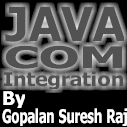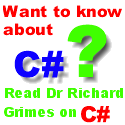




|
Java-COM Integration - Use Visual J++ to implement COM Objects Author: Gopalan Suresh Raj The wonderful thing about COM is that it is language neutral. However, it is reasonable to assume that its creators at Redmond developed the standard having Visual C++ and Visual Basic in mind. What is incredible is the fact that a language like Java, created by a direct competitor would mesh so well with COM - better than any other available language. Probably, one reason for this unusual fit is because, Java can support multiple interfaces. COM objects too support multiple interfaces. This and a few other features is what makes COM and Java a natural pair. COM Interfaces are immutable. An Interface defines a standard of communication between a client and its server. By defining a set of methods, the interface becomes the medium of communication between these two objects. In reality, an interface just defines the types of arguments and return values. A COM client directly calls functions provided by APIs in the Operating System. The COM client should also communicate with other COM objects using COM's low-level binding protocol. C++ programmers can do this with ease. However, Java programmers require a mapping layer in the Java Virtual Machine (VM) and a set of shim classes that provides for native calls to the OS. Microsoft's implementation of the Java Virtual Machine integrates Java objects and COM objects. One reason for this integration is because, from a COM client's point of view, the Java VM makes a Java Object appear to be another COM object. For example, if we were talking of a Java applet, the MS VM would automatically construct a dispinterface containing all the applet's public methods. With other Java objects, vtable interfaces are created. The MS VM also provides an implementation of IDispatch for this Java object. So, the object's methods are accessible to the clients of this object. The MS VM also provides an implementation of IUnknown for each Java object, allowing clients to acquire pointers to other interfaces the object supports. A Class Factory is also implemented allowing a client to treat the Java object like any other COM object. However, all this is transparent to the Java programmer. (S)he just creates and uses these objects as usual. All the services necessary to make Java objects look like COM objects are supplied transparently by the Microsoft's Java VM. From a Java object's point of view, an external COM object looks exactly like a Java object. Again this integration is achieved by the MS Java VM performing the necessary translations to map between the two kinds of objects. Java makes the life of a COM programmer relatively simple. For example, a programmer working with COM objects in C++ must always be aware of Reference Counting and ensure that Release() is called whenever an interface pointer is no longer used. Because Java supports Garbage Collection, this is not a concern for Java programmers. When MS VM notices that the "garbage" object being called is a COM object, it simply calls Release() on the object. Unlike C++ the creator of a Java COM client need not keep track of which COM objects are no longer needed and then release them. When acquiring references to new interfaces on an object, the MS VM hides calls to QueryInterface() beneath the Java language's built-in operators. The Java programmer writes the same code to access a new interface regardless of whether that interface is on a Java object or a COM object. In fact, (s)he cannot even tell them apart. For a COM object, however, the MS Java VM silently intercedes calling QueryInterface() on the object and returning the new interface pointer. Unlike C++ developers, COM programmers working in Java never need to make explicit QueryInterface() calls. To provide all the translations required to map between COM and Java, MS Java VM implementation relies on the information stored in a COM object's type library. And to furthur integrate Java into the COM world, MS offers Java class libraries exposing key COM functions such as CoCreateInstance(), along with access to monikers, Structured Storage and more. Although neither Java nor COM were designed with the other in mind, the two fit together really well. Shim classes that provide support for native calls to the OS are built using the JavaTlb.exe or utility that ships with MS Java SDK. When you execute this library from the command line and pass the type library of a COM component, it produces the required shim class files for the classes and interfaces that are required. You can then import these into your classes using the import keyword. Author: Gopalan Suresh Raj Gopalan Suresh Raj is a Software Architect, Developer and an active Author. He is contributing author to a couple of books "Enterprise JavaComputing-Applications and Architecture"(Cambridge University Press, June '99) and "TheAwesome Power of JavaBeans"(Manning, July'98). His expertise spans enterprise component architectures and distributed object computing. Visit him at his Web Cornucopia site (https://www.execpc.com/~gopalan)or mail him at [email protected]. Go to Gopalan's pages in Author Central. |

Contribute to IDR:
To contribute an article to IDR, a click here.
To contact us at IDevResource.com, use our feedback form, or email us. To comment on the site contact our webmaster. |
All content © Copyright 2000 IDevResource.com, Disclaimer notice |





